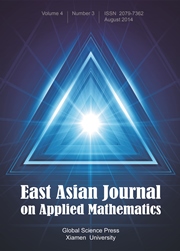No CrossRef data available.
Article contents
Estimation of a Regularisation Parameter for a Robin Inverse Problem
Published online by Cambridge University Press: 02 May 2017
Abstract
We consider the nonlinear and ill-posed inverse problem where the Robin coefficient in the Laplace equation is to be estimated using the measured data from the accessible part of the boundary. Two regularisation methods are considered — viz. L 2 and H 1 regularisation. The regularised problem is transformed to a nonlinear least squares problem; and a suitable regularisation parameter is chosen via the normalised cumulative periodogram (NCP) curve of the residual vector under the assumption of white noise, where information on the noise level is not required. Numerical results show that the proposed method is efficient and competitive.
Keywords
MSC classification
Information
- Type
- Research Article
- Information
- Copyright
- Copyright © Global-Science Press 2017
References
[1]
Alessandrini, G., Piero, L.D. and Rondi, L., Stable determination of corrosion by a single electrostatic boundary measurement, Inverse Problems
19, 973–984 (2003).Google Scholar
[2]
Cakoni, F. and Kress, R., Integral equations for inverse problems in corrosion detection from partial Cauchy data, Inverse Problems and Imaging
1, 229–245 (2007).Google Scholar
[3]
Chaabane, S., Elhechmi, C. and Jaoua, M., A stable recovery method for the Robin inverse problem, Math. Comput. Simul.
66, 367–383 (2004).Google Scholar
[4]
Chaabane, S., Feki, I. and Mars, N., Numerical reconstruction of a piecewise constant Robin parameter in the two- or three-dimensional case, Inverse Problems
28 065016, 19pp (2012).CrossRefGoogle Scholar
[5]
Chaabane, S., Fellah, I., Jaoua, M. and Leblond, J., Logarithmic stability estimates for a Robin coefficient in two-dimensional Laplace inverse problems, Inverse Problems
20, 47–59 (2004).Google Scholar
[6]
Chaabane, S. and Jaoua, M., Identification of Robin coefficients by the means of boundary measurements, Inverse Problems
15, 1425–1438 (1999).CrossRefGoogle Scholar
[7]
Chen, D., Maclachlan, S. and Kilmer, M., Iterative parameter-choice and multigrid methods for anisotropic diffusion denoising, SIAM J. Sci. Comput.
33, 2972–2994 (2011).Google Scholar
[8]
Choulli, M., On the determination of an unknown boundary function in a parabolic equation, Inverse Problems
15, 659–667 (1999).Google Scholar
[9]
Dennis, J. and Schnabel, R., Numerical Methods for Unconstrained Optimisation and Nonlinear Equations, SIAM (1996).Google Scholar
[10]
Fang, W. and Zeng, S., A direct solution of the Robin inverse problem, J. Integral Equ. Appl.
21, 545–557 (2009).Google Scholar
[11]
Fasino, D. and Inglese, G., An inverse Robin problem for Laplace's equation: Theoretical results and numerical methods, Inverse Problems
15, 41–48 (1999).Google Scholar
[12]
Fasino, D. and Inglese, D., Discrete methods in the study of an inverse problem for Laplace's equation, SIAM J. Numer. Anal.
19, 105–118 (1999).CrossRefGoogle Scholar
[13]
Golub, G.H., Heath, M. and Wahba, G., Generalised cross-validation as a method for choosing a good ridge parameter, Technometrics
21, 215–223 (1979).CrossRefGoogle Scholar
[14]
Hansen, P.C., Kilmer, M.E. and Kjeldsen, R.H., Exploiting residual information in the parameter choice for discrete ill-posed problems, BIT.
46, 41–59 (2006).Google Scholar
[15]
Hansen, P.C. and O’leary, D.P., The use of the L-curve in the regularisation of discrete ill-posed problems, SIAM J. Sci. Comput.
14, 1487–1503 (1993).Google Scholar
[16]
Inglese, G., An inverse problem in corrosion detection, Inverse Problems
13, 977–994 (1997).Google Scholar
[17]
Jin, B., Conjugate gradient method for the Robin inverse problem associated with the Laplace equation, Int. J. Numer. Meth. Eng.
71, 433–453 (2007).Google Scholar
[18]
Jin, B. and Maass, P., Sparsity regularisation for parameter identification problems, Inverse Problems
28 (2012) 123001–123071.Google Scholar
[19]
Jin, B. and Zou, J., Inversion of Robin coefficient by a spectral stochastic finite element approach, J. Comp. Phys.
227, 3282–3306 (2008).Google Scholar
[20]
Jin, B. and Zou, J., Numerical estimation of piecewise constant Robin coefficient, SIAM J. Control Optim.
48, 1977–2002 (2009).CrossRefGoogle Scholar
[22]
Lin, F. and Fang, W., A linear integral equation approach to the Robin inverse problem, Inverse Problems
21, 1757–1772 (2005).CrossRefGoogle Scholar
[23]
Ma, Y. and Lin, F., Conjugate gradient method for estimation of Robin coefficients, East Asian J. Appl. Math.
4, 189–204 (2014).Google Scholar
[24]
Mojabi, P. and LoVetri, J., Adapting the normalised cumulative periodogram parameter-choice method to the Tikhonov regularisation of 2-D/TM electromagnetic inverse scattering using born iterative method, Prog. Electromagn. Res. M
1, 111–138 (2008).Google Scholar
[25]
Morozov, V.A., Nashed, Z. and Aries, A.B., Methods for Solving Incorrectly Posed Problems, Springer, New York (1984).Google Scholar
[26]
Rust, B.W. and O’Leary, D.P., Residual periodograms for choosing regularisation parameters for ill-posed problems, Inverse Problems
24, 34005–34034 (2008).Google Scholar

